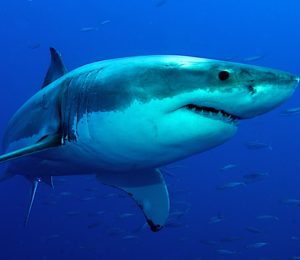
White Sharks – the world’s largest predatory fish – have the impressive ability to follow the direction of the sun to hunt their prey, new research from Flinders University reveals.
The study, published in American Naturalist, and reported on national TV this week, is the first of its kind to empirically show that White Sharks can exploit the sun when approaching baits by positioning the sun directly behind them.
The research – led by Flinders shark ecologist Dr Charlie Huveneers – observed more than 950 hunting approaches by 44 different sharks in South Australian waters over
30 days, finding that White Sharks strategically approached their prey with the sun directly behind them more often than from other directions.
The sharks were attracted to the research boat using standard berley and tuna, enabling investigations of unrestrained wild sharks.
Lead author Dr Huveneers said that on sunny days, sharks reversed their direction of approach from the east in the morning to the west in the afternoon, but approached the bait from no specific direction on overcast days.
“The sharks’ approach direction did not correlate with other potential behavioural drivers, such as the boat or wind direction which could affect the dispersal of the odour trail, therefore supporting our hypothesis that sharks can track the position of the sun and use this cue to coordinate their approach,” Dr Huveneers said.
Dr Huveneers said the sun-tracking strategy has a number of potential advantages, including improving prey detection and reducing sun glare.
“Sharks might use the sun to increase the contrast between their prey and the surrounding water, making prey easier to see.
“By approaching prey with the sun behind them, they could also be reducing any disabling glare from the sun.”
Dr Huveneers said future studies will focus on understanding the differences in predation strategies between individual sharks, and why some sharks used this sun-tracking strategy more than others.
You can see Channel Nine’s national news coverage this week of Dr Huveneers’ research here.

